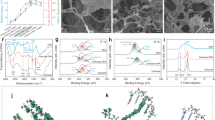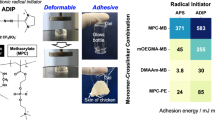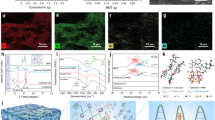Abstract
Bio-based biodegradable hydrogels were prepared by crosslinking microbial homo poly(amino acid), poly(γ-glutamic acid) (PGA), with L-lysine in a one-pot synthesis in the presence of 4-(4,6-dimethoxy-1,3,5-triazin-2-yl)-4-methylmorpholinium chloride (DMT-MM) at 25 °C. The crosslinking was carried out in aqueous solution and the yields of the gels prepared with DMT-MM were higher than those prepared with water-soluble carbodiimide. The water absorption of the PGA gels crosslinked with L-lysine ranged from 300 to 2100 g/g. The water absorption of the PGA gel was affected by the amount of crosslinker and DMT-MM, which had an effect on the crosslinking density of the PGA gel. It was confirmed in a hydrolysis test in a buffer of pH 9 at 37 °C that the obtained gel that was crosslinked with L-lysine by amide bonds was more resistant to hydrolysis than the gel crosslinked by ester bonds. biochemical oxygen demand-biodegradability of the PGA gel crosslinked with L-lysine reached 60% in activated sludge at 25 °C.
Similar content being viewed by others
Log in or create a free account to read this content
Gain free access to this article, as well as selected content from this journal and more on nature.com
or
References
Doi, Y., Kunioka, M., Nakamura, Y. & Soga, K. Nuclear magnetic resonance studies on unusual bacterial copolyesters of 3-hydroxybutyrate and 4-hydroxybutyrate. Macromolecules 21, 2722–2727 (1988).
Hara, T., Anmayr, A., Fujo, Y. & Ueda, S. Elimination of plasmid-linked polyglutamate production by Bacillus subtilis (natto) with acridine orange. Appl. Environ. Microbiol. 44, 1456–1458 (1982).
Shima, S. & Sakai, H. Poly-L-lysine produced by streptomyces. Part III. Chemical studies. Agric. Biol. Chem. 45, 2503 (1981).
Kubota, H., Matsunobu, T., Uotani, K., Takebe, H., Satoh, A., Tanaka, T. & Taniguchi, M. Production of poly(γ-glutamic acid) by Bacillus subtilis F-2-01. Biosci. Biotech. Biochem. 57, 1212 (1993).
Kunioka, M. Biosynthesis of poly (γ-glutamic acid) from L-glutamine, citric acid and ammonium sulfate in Bacillus subtilis IF0335. Appl. Microbiol. Biotechnol. 44, 501–506 (1995).
Choi, H. J. & Kunioka, M. Preparation conditions and swelling equilibria of biodegradable hydrogels prepared from microbial poly(γ-glutamic acid) and poly(ɛ-lysine). J. Environ. Polym. Degrad. 4, 123–129 (1996).
Kunioka, M. & Choi, H. J. Hydrolytic degradation and mechanical properties of hydrogels prepared from microbial poly (amino acid)s. Polym. Degrad. Stabil. 59, 33–37 (1998).
Gonzales, D., Fan, K. & Sevoian, M. Synthesis and swelling characterizations of a poly(γ-glutamic acid) hydrogel. J. Polym. Sci. Part A Polym. Chem. 34, 2019–2027 (1996).
Fan, K., Gonzales, D. & Sevoian, M. Hydrolytic and enzymatic degradation of poly(γ-glutamic acid) hydrogels and their application in slow-release systems for proteins. J. Environ. Polym. Degrad. 4, 253–260 (1996).
Kunioka, M. & Furusawa, K. Poly(γ-glutamic acid) hydrogel prepared from microbial poly(γ-glutamic acid) and alkanediamine with water-soluble carbodiimide. J. Appl. Polym. Sci. 65, 1889–1896 (1997).
Kunioka, M. Biodegradable water absorbent synthesized from bacterial poly(amino acid)s. Macromol. Biosci. 4, 324–329 (2004).
Choi, H. J. & Kunioka, M. Preparation of conditions and swelling equibria of hydrogels prepared by γ-irradiation from microbial poly (γ-glutamic acid). Radiat. Phys. Chem. 46, 175–179 (1995).
Shimokuri, T., Kaneko, T., Serizawa, T. & Akashi, M. Preparation and thermosensitivity of naturally occurring polypeptide poly(γ-glutamic acid) derivatives modified by propyl groups. Macromol. Biosci. 4, 407–411 (2004).
Murakami, S. & Aoki, N. Bio-based hydrogels prepared by cross-linking of microbial poly(γ-glutamic acid) with various saccharides. Biomacromolecules 7, 2122–2127 (2006).
Anastas, P. T. & Williamson, T. C. Green Chemistry: Frontiers in Benign Chemical Synthesis and Processes 1–26 (Oxford University Press, NY, 1998).
Kunishima, M., Kawachi, C., Morita, J., Terao, K., Iwasaki, F. & Tani, S. 4-(4,6-Dimethoxy-1,3,5-triazin-2-yl)-4-methyl-morpholinium chloride: an efficient condensing agent leading to the formation of amides and esters. Tetrahedron 55, 13159–13170 (1999).
Kunishima, M., Kawachi, C., Hioki, K., Terao, K. & Tani, S. Formation of carboxamides by direct condensation of carboxylic acids and amines in alcohols using a new alcohol- and water-soluble condensing agent: DMT-MM. Tetrahedron 57, 1551–1558 (2001).
Bidlingmeyer, B. A., Cohen, S. A. & Tarvin, T. L. Rapid analysis of amino acids using pre-column derivatization. J. Chromatogr. 336, 93–104 (1984).
Author information
Authors and Affiliations
Corresponding author
Rights and permissions
About this article
Cite this article
Murakami, S., Aoki, N. & Matsumura, S. Bio-based biodegradable hydrogels prepared by crosslinking of microbial poly(γ-glutamic acid) with L-lysine in aqueous solution. Polym J 43, 414–420 (2011). https://doi.org/10.1038/pj.2010.142
Received:
Revised:
Accepted:
Published:
Issue date:
DOI: https://doi.org/10.1038/pj.2010.142
Keywords
This article is cited by
-
Advanced methodologies for the cleaning of works of art
Science China Technological Sciences (2023)
-
High-performance bio-based bismaleimide resins using succinic acid and eugenol
Polymer Journal (2011)



